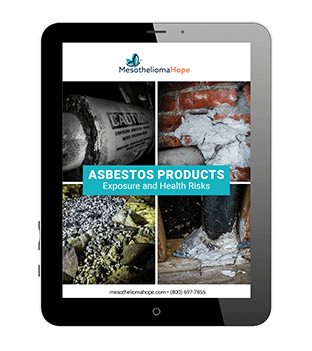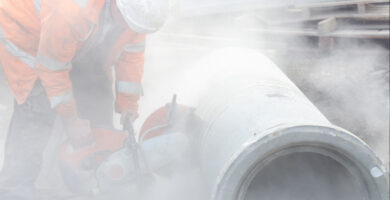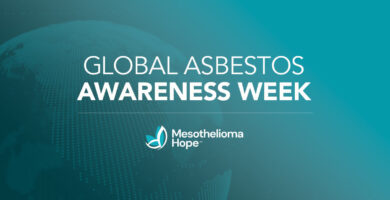Asbestos is a dangerous mineral that can cause mesothelioma, a rare and aggressive cancer, and other serious diseases. The substance was used in thousands of products across multiple industries before the dangers were made public after decades of cover-up by asbestos companies.
Asbestos fibers are usually too small to be seen by the naked eye, which can make it impossible to tell if you’re breathing them in. Additionally, symptoms of mesothelioma and other asbestos-related diseases can take 10-50 years to show up.
It may be hard to recall when or where you encountered the cancer-causing mineral since asbestos diseases take decades to become noticeable. However, if you worked in a blue-collar industry prior to the 1980s or served in the U.S. military, the odds are high that you were exposed to asbestos.
If you’ve been diagnosed with mesothelioma, you may be eligible for financial compensation even if you can’t remember the details of your asbestos exposure.
Answer the questions below to learn how you might have been exposed and what you can do to seek financial assistance after a mesothelioma diagnosis.
Did You Serve in the U.S. Military?
Every branch of the U.S. military used asbestos between the 1930s and early 1980s. The mineral helped make construction products and other materials heat-resistant and durable, qualities that were necessary in nearly every piece of military equipment, including aircraft, buildings, and transport vehicles.
U.S. Navy ships, in particular, used asbestos-containing materials extensively for insulation in engine rooms, boiler rooms, and other high-temperature areas.
As a result, many veterans were exposed to large amounts of asbestos fibers every day, especially if they performed maintenance on asbestos-containing equipment. Today, veterans make up 33% of all mesothelioma cases.
If you served in the military before the early 1980s, it’s likely you were exposed to asbestos. Download our Free Asbestos Products Guide to learn more about how you might have been exposed and what you can do next.
Did You Work in a High-Risk Industry?
Blue-collar workers were exposed to alarming levels of asbestos because of the materials they worked with every day.
At-risk industries for asbestos exposure include:
- Aircraft maintenance
- Auto repair
- Boiler work
- Construction
- Electrical
- Firefighting
- Mining
- Plumbing
- And more
Because workers in these industries handle asbestos-containing materials on a daily basis — from cement pipes to brake pads — it was nearly impossible for them to avoid airborne asbestos fibers.
Workers in these occupations may still be at risk of exposure today when working on older buildings and equipment.
Did a Loved One Work in a High-Risk Job?
Men and women in high-risk industries may have encountered so much asbestos dust that it settled on their clothing, hair, and shoes. After work, they may have brought asbestos fibers home with them, putting everyone they lived with at risk.
This is known as secondhand asbestos exposure, and it is as serious as occupational exposure. One asbestos fiber can cause irreversible damage to the lining of the lungs and other organs once breathed in or swallowed.
Julie Gundlach’s father worked as an electrician and brought asbestos home on his work clothes every night, unaware of the dangers. Decades later, Julie was diagnosed with peritoneal mesothelioma, a rare cancer that develops in the abdominal lining. Read Julie’s full story here.
Did You Live or Work in an Old Building?
Before the dangers of asbestos were widely understood, construction materials like insulation, flooring and ceiling tiles, and cement foundations commonly included asbestos. All of these asbestos products were meant to be cost-effective, durable, and fire-resistant.
However, asbestos-containing materials can break down or fall apart after years of wear and tear. Once this happens, it can put everyone in the building at risk of exposure.
If your home or workplace was built before the 1980s, it’s likely to contain some amount of asbestos materials. Most of the time, these materials are considered safe if left undisturbed.
Some types of older buildings that may still contain asbestos include:
- Commercial buildings and shops
- Homes
- Office buildings
- Schools
- Warehouses
Learn more about the risks of asbestos and what you can do to keep you and your loved ones safe in our Free Asbestos Products Guide.
4 Tips on What to Do If Exposed to Asbestos
If you believe you have been exposed to asbestos, there are actionable steps you can take to protect your health and well-being.
Here are 4 things you can do after possible exposure to asbestos:
- Quit smoking: Smoking can further damage tissues that have already been impacted by asbestos fibers, increasing the risk of mesothelioma.
- Talk to your doctor about your exposure history: Having a record of potential asbestos exposure can help your health care team be mindful of emerging symptoms.
- Get routine cancer screenings: The sooner you get a mesothelioma diagnosis, the sooner you can start treatment and potentially improve your life expectancy.
- Take protective measures to reduce future exposure: If you have asbestos in your home, hire a certified asbestos abatement professional to safely remove it. If you work in a high-risk occupation, follow all safety protocols, such as wearing protective equipment.
How We Can Help Asbestos Victims
Mesothelioma Hope is committed to helping victims of asbestos exposure find the support they need to navigate their journey.
If you’ve been diagnosed with mesothelioma or another asbestos-related disease, we can track down when and where you were exposed and help you pursue financial assistance for treatment.
Connect with a Patient Advocate now at (866) 608-8933 or fill out our contact form to get started.










